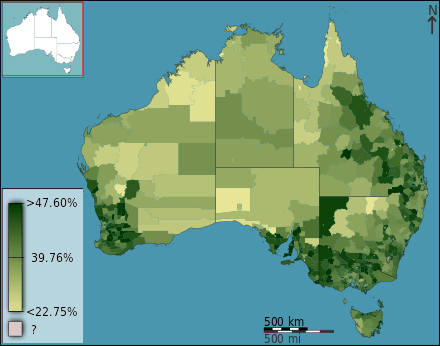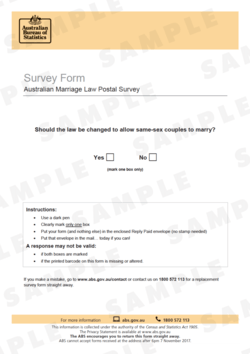Marriage in Australia


As was the case for other Western countries, marriage in Australia for most of the 20th century was done early and near-universally, particularly in the period after World War II to the early 1970s. Marriage at a young age was most often associated with pregnancy prior to marriage.[1]
Marriage was once seen as necessary for couples who cohabited. While some couples did cohabit before marriage, it was relatively uncommon up until the 1950s in much of the Western world.[2] If both partners are under the age of 18, marriage in Australia is not permitted. In ‘exceptional circumstances’ the marriage of persons under 18 but over 16 may be authorised by a court.
The official registration of marriage is the responsibility of each state and territory.[3] A Notice of Intended Marriage is required to be lodged with the chosen celebrant.[4]
According to a 2008 Relationships Australia survey love, companionship and signifying a lifelong commitment were the top reasons for marriage.[5]
History

In colonial New South Wales marriage was often an arrangement of convenience. For female convicts, marriage was a way of escaping incarceration. Land leases were denied to those who were unmarried.[6]
Until 1961, each Australian state and territory administered its own marriage laws. The Marriage Act 1961 (Cth) was the first federal law on the matter and set uniform Australia-wide rules for the recognition and solemnisation of marriages. In its current form, the Act recognises only monogamous (heterosexual or same-sex) marriages and does not recognise any other forms of union, such as traditional Aboriginal marriages[7] or polygamous marriages.
The Family Law Act 1975 (Cth) made it easier to divorce and removed the concept of fault, requiring only a twelve-month period of separation.[8] The 1970s saw a significant rise in the divorce rate in Australia.[1] This change has been attributed to a change in social attitudes: having once been considered acceptable only if there were severe problems, divorce was now widely considered acceptable if it was the preference of the partners.[9]
In 2004, the Liberal Howard Government enacted the Marriage Amendment Act 2004 to expressly ban same-sex marriage in Australia. It defined marriage as "the union of a man and a woman to the exclusion of all others, voluntarily entered into for life".
Until the enactment of the 2004 amendment, there was no definition in the 1961 Act of "marriage", and the common law definition used in the English case Hyde v Hyde (1866) was taken as applicable.[10] The definition pronounced by Lord Penzance in the case was: "I conceive that marriage, as understood in Christendom, may for this purpose be defined as the voluntary union for life of one man and one woman, to the exclusion of all others".[11] The 2004 amendment also banned the recognition of same-sex marriages performed in a foreign country.[12] The definition of marriage was added to the wedding ceremony speeches as a monitum; without it, ceremonies would be considered invalid.[13]
In 2009, the Labor Rudd Government enacted the Family Law Act 2009, which recognised the property rights of each partner of a de facto relationship, including a same-sex relationship, for the purposes of the Family Law Act 1975.
The 2014 Marriage Amendment (Celebrant Administration and Fees) Act amended the Marriage Act 1961 in relation to celebrants and other issues.[14]
The 2017 Marriage Amendment (Definition and Religious Freedoms) Act again changed the definition of "marriage" under the Marriage Act 1961, replacing the words "a man and a woman" with "2 people" and therefore allowing monogamous same-sex marriages. The Act also reversed the 2004 Amendment and retrospectively recognised same-sex marriages performed in a foreign country, provided that such marriages were permitted under the laws of that foreign country.
Social change
In 2009, the Australian Bureau of Statistics noted that "The proportion of adults living with a partner has declined during the last two decades, from 65% in 1986, to 61% in 2006". The proportion of Australians who are married fell from 62% to 52% over the same period.[15]
Common-law marriages have increased significantly in recent decades, from 4% to 9% between 1986 and 2006.[15] Cohabitation is often a prelude to marriage and reflects an increasing desire to attain financial independence before having children.[16] In 2015, 81% of all those marrying were already living together.[17]
Since 1999, civil celebrants have overseen the majority of marriages. In 2016, 76.4% of marriages were solemnised by a civil celebrant.[18]
Since its inception, the Commonwealth Public Service had placed a bar on employment of married women, meaning that married women could only be employed as temporary staff. Any female employee was required to resign upon marrying. This bar restricted women's opportunities for promotion. It was lifted in 1966 after a long campaign.[19][20]
In 1971, more than three quarters of women surveyed placed being a mother before their career. By 1991 this figure had dropped to one quarter.[8]
By the 1980s there was a clear trend towards delaying first marriage. In 1989, more than one woman in five had not married by the age of 30.[1] Between 1990 and 2010, the median age at first marriage increased by more than three years for both women and men (from 24.3 years to 27.9 years for women, and from 26.5 years to 29.6 years for men).[21]
Divorce in Australia
The crude divorce rate was 2.0 divorces per 1,000 estimated resident population in 2014 and 2015, down from 2.1 in 2013. The median duration from marriage to divorce in 2015 was 12.1 years. The median age at divorce was 45.3 years for men and 42.7 years for women.[17]
Same-sex marriage

Same-sex marriage became legal in Australia in December 2017, after the Federal Parliament passed the Marriage Amendment (Definition and Religious Freedoms) Act 2017.[22]
The Marriage Act 1961 (Australia's first federal marriage legislation) did not include a definition of marriage; it left that definition to the common law.[23] The Marriage Amendment Act 2004 defined, for the first time by statute, marriage as "the union of a man and a woman to the exclusion of all others, voluntarily entered into for life."[24][25] This was in response to a lesbian couple getting married in Canada and applying for their marriage to be recognised in Australia.[26]
Since 2009, same-sex couples have been included in Australia's de facto relationship laws, unions which provide couples with most, though not all, of the same rights as married couples.[27][28]
Same-sex and opposite-sex couples can also access domestic partnership registries in New South Wales, Tasmania, South Australia and Victoria. Civil partnerships/unions are performed in Queensland and the Australian Capital Territory. Western Australia and the Northern Territory do not recognise civil unions, civil partnerships or a relationship register, but do recognise the unregistered cohabitation of de facto couples under their laws.
The Australian Marriage Law Postal Survey was a nationwide survey on same-sex marriage held in Australia between 12 September and 7 November 2017. As the survey shares some characteristics with a plebiscite, it is also informally referred to as a plebiscite or postal vote. The survey returned a 61.6% "Yes" response in favour of same-sex marriage, and the Marriage Amendment (Definition and Religious Freedoms) Act 2017, which amends the definition of marriage and legalises same-sex marriage in Australia, passed the Parliament on 7 December 2017.[29] The bill received royal assent the following day and went into effect on 9 December 2017.[30][31]
See also
References
- 1 2 3 McDonald, P. (1992). "The 1980s: Social and Economic Change Affecting Families". In Jagtenberg, Tom; D'Alton, Phillip. Four Dimensional Social Space. Pymble, Sydney: Harper Educational Publishers. pp. 126–128. ISBN 0063121271.
- ↑ Thornton, Arland; William G. Axinn; Yu Xie (2008). Marriage and Cohabitation. University of Chicago Press. p. 72. ISBN 0226798682. Retrieved 3 August 2013.
- ↑ "Births, deaths and marriages – Fact sheet 89". National Archives of Australia. Retrieved 3 August 2013.
- ↑ "Your Legal Obligations". Australian Marriage Celebrants. Retrieved 3 August 2013.
- ↑ "Why do people get married?". Relationships Australia. Retrieved 3 August 2013.
- ↑ Edgar, Don (2012). Men Mateship Marriage. HarperCollins Australia. ISBN 0730496589. Retrieved 3 August 2013.
- ↑ Australian Government, Law Reform Commission - Aboriginal Traditional Marriage: Areas for Recognition
- 1 2 Clancy, Laurie (2004). Culture and Customs of Australia. Greenwood Publishing Group. pp. 57–58. ISBN 0313321698. Retrieved 3 August 2013.
- ↑ Halford, W. Kim (2011). Marriage and Relationship Education: What Works and How to Provide It. Guilford Press. p. 13. Retrieved 3 August 2013.
- ↑ Hyde v. Hyde and Woodmansee {L.R.} 1 P. & D. 130.
- ↑ Hyde v Hyde casenote Archived 2014-03-29 at Archive.is.
- ↑ The 2004 Amendment inserted 88EA "Certain unions are not marriages" into the 1961 Act.
- ↑ "Couples seek to bypass 'downer' legal passage in wedding vows". ABC News. 1 June 2015. Retrieved 10 December 2017.
- ↑ https://www.legislation.gov.au/Details/C2014A00025
- 1 2 http://www.abs.gov.au/AUSSTATS/abs@.nsf/Lookup/4102.0Main+Features20March%202009
- ↑ Uhlmann, Allon J. (2006). Family, Gender and Kinship in Australia: The Social and Cultural Logic of Practice and Subjectivity. Ashgate Publishing. p. 31. ISBN 0754680266. Retrieved 3 August 2013.
- 1 2 http://www.abs.gov.au/ausstats/abs@.nsf/mf/3310.0
- ↑ "Marriages and Divorces, Australia, 2016". Australian Bureau of Statistics. ABS. 28 Nov 2017. Retrieved 10 April 2016.
- ↑ http://timeline.awava.org.au/archives/264
- ↑ "The long, slow demise of the "marriage bar" | Inside Story". Inside Story. 2016-12-08. Retrieved 2018-01-28.
- ↑ Statistics, c=AU; o=Commonwealth of Australia; ou=Australian Bureau of. "Main Features - Love Me Do". www.abs.gov.au. Retrieved 2018-01-28.
- ↑ "Same-sex marriage bill passes House of Representatives, paving way for first gay weddings". ABC News. 7 December 2017.
- ↑ Michael, Quinlan, (2016). "Marriage, Tradition, Multiculturalism and the Accommodation of Difference in Australia". The University of Notre Dame Australia Law Review. 18 (1). ISSN 1441-9769.
- ↑ "Marriage Amendment Act 2004". comlaw.gov.au.
- ↑ "Marriage Amendment Act 2004". comlaw.gov.au.
- ↑ Wall, Louisa (13 October 2017). "Australia's marriage equality process did not have to be so politicised | Louisa Wall". The Guardian. Retrieved 15 October 2017.
- ↑ "SSM: What legal benefits do married couples have that de facto couples do not?". ABC News. Australian Broadcasting Corporation. 21 September 2017.
- ↑ "FAMILY LAW ACT 1975 - SECT 4AA De facto relationships". www.austlii.edu.au. Retrieved 2016-09-23.
- ↑ "Same-sex marriage bill passes House of Representatives, paving way for first gay weddings". ABC News. 7 December 2017.
- ↑ "Same-sex marriage signed into law by Governor-General, first weddings to happen from January 9". ABC News. 8 December 2017.
- ↑ "When can you lodge your Notice for Intended Marriage?". ABC News. 7 December 2017. Retrieved 7 December 2017.
External links
| Wikimedia Commons has media related to Marriage in Australia. |
- Getting married - Government information
- Births, deaths and marriages registries - Government information